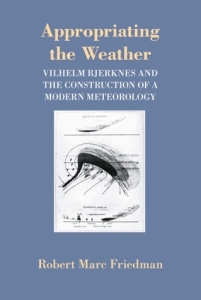This week I’m reading my way through three biographies, which neatly capture the work of three key scientists who laid the foundation for modern climate modeling: Arrhenius, Bjerknes and Callendar.
- Crawford, E. (1996). Arrhenius: From Ionic Theory to the Greenhouse Effect. Science History Publications.
- A biography of Svante Arrhenius, the Swedish scientist who, in 1895, created the first computational climate model, and spent almost a full year calculating by hand the likely temperature changes across the planet for increased and decreased levels of carbon dioxide. The term “greenhouse effect” hadn’t been coined back then, and Arrhenius was more interested in the question of whether the ice ages might have been caused by reduced levels of CO2. But nevertheless, his model was a remarkably good first attempt, and produced the first quantitative estimate of the warming expected from human’s ongoing use of fossil fuels.
- Friedman, R. M. (1993). Appropriating the Weather: Vilhelm Bjerknes and the Construction of a Modern Meteorology. Cornell University Press.
- A biography of Vilhelm Bjerknes, the Norwegian scientist, who, in 1904, identified the primitive equations, a set of differential equations that form the basis of modern computational weather forecasting and climate models. The equations are, in essence, an adaption of the equations of fluid flow and thermodynamics, adapted to represent the atmosphere as a fluid on a rotating sphere in a gravitational field. At the time, the equations were little more than a theoretical exercise, and we had to wait half a century for the early digital computers, before it became possible to use them for quantitative weather forecasting.
- Fleming, J. R. (2009). The Callendar Effect: The Life and Work of Guy Stewart Callendar (1898-1964). University of Chicago Press.
- A biography of Guy S. Callendar, the British scientist, who, in 1938, first compared long term observations of temperatures with measurements of rising carbon dioxide in the atmosphere, to demonstrate a warming trend as predicted by Arrhenius’ theory. It was several decades before his work was taken seriously by the scientific community. Some now argue that we should use the term “Callendar Effect” to describe the warming from increased emissions of carbon dioxide, because the term “greenhouse effect” is too confusing – greenhouse gases were keeping the planet warm long before we started adding more, and anyway, the analogy with the way that glass traps heat in a greenhouse is a little inaccurate.
Not only do the three form a neat ABC, they also represent the three crucial elements you need for modern climate modelling: a theoretical framework to determine which physical processes are likely to matter, a set of detailed equations that allow you to quantify the effects, and comparison with observations as a first step in validating the calculations.




I do hope climate modeling will extend into a vox populi world of computer gaming… interesting to see possibilities to move through data … like the HoloLens device – perhaps an indulgent hobby, but it would reach a tremendous audience.
https://www.youtube.com/watch?v=iu0gM0_vxIM (notice the globe)
http://www.alphr.com/microsoft/microsoft-hololens
https://www.youtube.com/watch?v=xgakdcEzVwg (it is obvious that a global warming simulation should be built for this device)
http://www.theverge.com/2015/7/8/8914815/microsoft-hololens-demo-video
https://www.microsoft.com/microsoft-hololens/en-us